
Which EVOM™ Electrode is Right for Your Application?
Which EVOM™ Electrode is Right for Your Application?
WPI’s EVOM™ Manual is the gold standard for delivering stable and repeatable Trans Epithelial Electrical Resistance (TEER) measurements. The EVOM™ Manual is the newest TEER meter. It qualitatively measures cell monolayer health and quantitatively measures cell confluence by determining an increase or a plateau in tissue resistance detected using our innovative EVOM™ technology. WPI’s state of the art EVOM™ technology provides you with real-time, valuable feedback during experimental measurements.
![]()
Electrode options are available for use with the new EVOM™ Manual. Here we will compare these options so you can choose one that’s right for your application.
- With STX electrodes, you can measure inside the well plate. The STX4 electrode is our new and improved version of the STX2-PLUS electrode. It has removable blades.
- STX HTS electrodes are ideal for high throughput screening (HTS) plates.
- EndOhm electrodes by design are considered more accurate in capturing smaller changes. However, cell culture inserts need to be physically moved out of the plate to the EndOhm chamber for measurement.
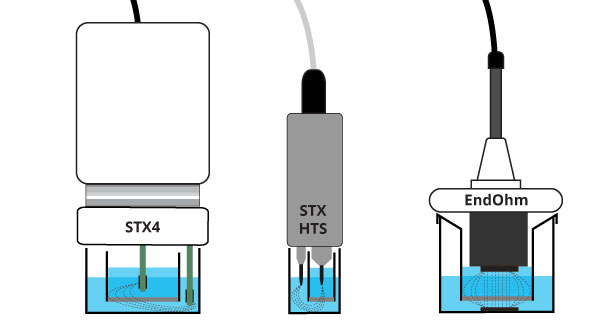
This figure demonstrates how the EVOM™ electrodes measures TEER. With a fixed centered electrode geometry of the EndOhm, the variation of readings on the same sample is 1-2 Ω, as compared to 5% of the total reading using the STX2 electrodes. An EndOhm, together with the EVOM™ Manual, offers the most accurate, convenient and economical solution for trans membrane electrical resistance measurement.
For automation of TEER measurements, consider the REMS AutoSampler that integrates a robotic system and computer interface to automatically measure tissue resistance in 24- and 96-well plates.
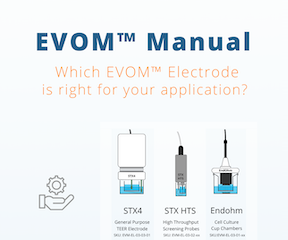
Download the electrode comparison chart.
STX4
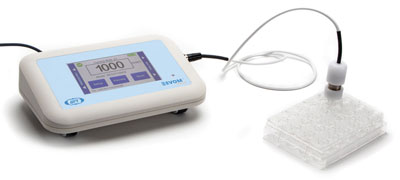 The STX4 electrode is the general-purpose electrode for the manually operated EVOM™ meters like the EVOM™ Manual and EVOM3. With an adapter it may also be used with older versions of the EVOM and Millicell® meters. It is balanced and weighted for hands-free operation, and the shallow electrode tips require less fluid than previous hand-held electrodes. Its design offers greater precision when compared with the STX2 and STX3. This electrode is the only one with replaceable blades. This means you never need to chloride the tips, and you may replace the blades instead of the entire electrode. This extends the life of your electrode. The STX4 is designed for use with 24-well plates.
The STX4 electrode is the general-purpose electrode for the manually operated EVOM™ meters like the EVOM™ Manual and EVOM3. With an adapter it may also be used with older versions of the EVOM and Millicell® meters. It is balanced and weighted for hands-free operation, and the shallow electrode tips require less fluid than previous hand-held electrodes. Its design offers greater precision when compared with the STX2 and STX3. This electrode is the only one with replaceable blades. This means you never need to chloride the tips, and you may replace the blades instead of the entire electrode. This extends the life of your electrode. The STX4 is designed for use with 24-well plates.
STX HTS
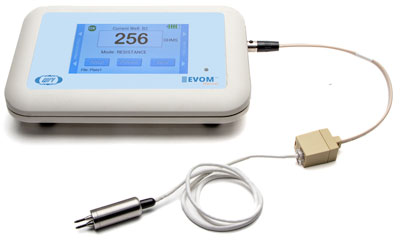 The STX HTS electrodes are designed for high throughput screening, because the tips are much smaller, and the electrode is keyed to fit neatly into the filter wells. The design improves accuracy over the STX2 and STX3, and it is more durable, too. The size of the electrodes and the design reduces the chances of sample contamination. This is an excellent choice for 24- and 96-well plates. (TITLE: Corning 96, Corning Biocoat/Falcon 24, Corning Costar 24, Millipore 96)
The STX HTS electrodes are designed for high throughput screening, because the tips are much smaller, and the electrode is keyed to fit neatly into the filter wells. The design improves accuracy over the STX2 and STX3, and it is more durable, too. The size of the electrodes and the design reduces the chances of sample contamination. This is an excellent choice for 24- and 96-well plates. (TITLE: Corning 96, Corning Biocoat/Falcon 24, Corning Costar 24, Millipore 96)
EndOhm
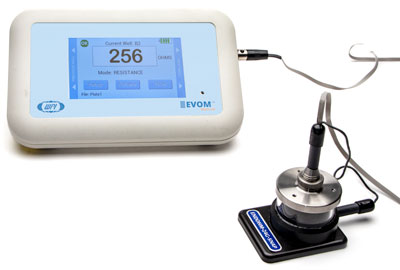 EndOhm cell culture cup chambers are built for stability and reproducibility to 1% tolerance. These chambers are ideal when precision counts. Three sizes are available: 6mm, 12mm and 24mm for 24-, 12- and 6-well plates. The tri-leg supports provide mechanical stability and holds the membrane parallel to the electrodes. The symmetrical electrode pattern disperses the test current uniformly, giving the most accurate reading of all the EVOM electrodes. However, each well must be individually positioned inside the EndOhm chamber to make a reading.
EndOhm cell culture cup chambers are built for stability and reproducibility to 1% tolerance. These chambers are ideal when precision counts. Three sizes are available: 6mm, 12mm and 24mm for 24-, 12- and 6-well plates. The tri-leg supports provide mechanical stability and holds the membrane parallel to the electrodes. The symmetrical electrode pattern disperses the test current uniformly, giving the most accurate reading of all the EVOM electrodes. However, each well must be individually positioned inside the EndOhm chamber to make a reading.
The EVOM™ Manual requires an electrode for use. Choose an electrode suitable for your application.
| Cell Culture Insert/Transwell Type | Electrode | Advantages | Disadvantages |
| Removable 24-well | STX4 | No need to transfer inserts. Take measurments in the plate. | |
| Removable 24-well | EndOhm-6 | Most accurate mode of measurement, because of the larger electrode surface area and the concentric positioning of the electrodes. | Need to transfer inserts into the EndOhm chamber for making measurements. |
| Removable 12-well | EndOhm-12 | ||
| Removable 6-well | EndOhm-24 | ||
| 24- or 96-well High Throughput Screening (HTS) Plates | STX HTS | Fits perfectly in the measurment plate. Choose the option based on your specific plate. |




Request
Catalogue
Chat
Print